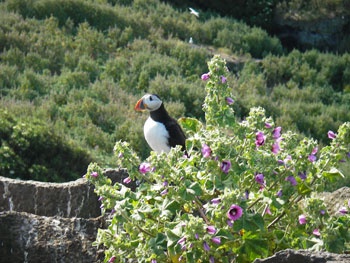First results released today from the SOS Puffin project in the Firth of Forth reveal that the puffins are fighting back! SOS Puffin, a new project to save the plight of a shrinking puffin colony in the Firth of Forth, was launched this summer by the award-winning Scottish Seabird Centre at North Berwick.
The project involves an academic from the University of Aberdeen, Rene van der Wal, who is a Senior Lecturer for the Aberdeen Centre for Environmental Sustainability, responsible for setting up the project. Rene is a research scientist and he has been involved in collating the early findings of the project. His role has also included providing scientific advice and ensuring that the project is progressing as it should.
SOS Puffin is an ambitious partnership project which aims to turn around the fortunes of an important puffin colony on the island of Craigleith, as well as the island of Fidra (an RSPB Reserve), in the Firth of Forth, close to the Seabird Centre, made possible with £1/4 million from Viridor Credits landfill tax funding.
Formerly one of the largest colonies in Britain, puffin numbers on Craigleith had plummeted from 28,000 pairs in 1999 to just a few thousand in 2006. This crash was due to a non-native invasive plant tree mallow (Lavatera arborea) which grows to over two metres and, partly as a result of climate change, had completely taken over the island, choking the puffins' burrows and preventing them from rearing their chicks or "pufflings".
The SOS Puffin team of over 100 volunteers from across Scotland, who have been working on the project since the end of last year, succeeded in clearing three acres of the island of tree mallow just in time for the puffins returning to nest in mid April. Drawn instinctively to where they are born, the puffins needed no encouragement, (for example, in the form of wooden decoys or puffin recordings) and according to one volunteer from the team, "The puffins looked as if they were waiting in the wings for us to leave, as we boarded the boat home on the last day!"
The first results received today from the monitoring work have shown that the hard work is already paying dividends, with both puffins and native vegetation benefiting. In the areas where the volunteers have been active, tree mallow cover has been reduced to 28% or less and, notably, as many as 96% of the burrows in the monitoring plots are now being occupied by the puffins, compared to 30% in the areas where tree mallow wasn't cut back. No new burrows have been dug by the puffins, suggesting that the removal of the plant has opened up sufficiently high numbers of old burrows for them to inhabit.
Chief Executive of the Scottish Seabird Centre, Tom Brock OBE said: "Scotland is home to 45 per cent of all the seabirds in Europe. However, the very survival of our seabirds is being threatened. In many parts of Scotland, some seabird species have had a disastrous breeding season, due to lack of food – chicks have been starving to death. The Scottish Seabird Centre is committed to raising public awareness of these issues threatening Scotland's unique wildlife and to taking action, where we can. The initial results from SOS Puffin bring some excellent news and provide a good example of human intervention being used to positive effect. The SOS Puffin team is delighted with the initial findings. No-one, particularly the University of Aberdeen Research scientist in the team, expected such good results, so quickly."
The Viridor Credits landfill tax funding also provided for a new generation of solar powered cameras. These include the Puffin Burrow Cams and Clifftop Cam which are now beaming back incredible live interactive pictures of the puffins' progress for visitors at the Seabird Centre and scientists, monitoring the project. They may also be seen on the internet on live webcams at www.seabird.org. The puffins should still be on the islands for approximately another week or two, before the pufflings set off to fend for themselves and the parents head back out to sea. People therefore don't have much time left to come down to the Seabird Centre at North Berwick and use the cameras to zoom in on one of Scotland's most popular wild birds.
The funding is also being used to observe and conserve the precious kittiwake colony at Dunbar Harbour, the most accessible, and one of the most vulnerable in the UK, and also to develop a new education and community programme involving people, in particular young people, living in the area.
The programme is part of a five year plan and much more work lies ahead, but the team is delighted with the results so far. Volunteers are needed to help out again soon, when the puffins leave and anyone who is interested should call 01620 890202 or email href="mailto:info@seabird.org">info@seabird.org</a>.
Press are invited to the Seabird Centre on Wednesday 25th July (14.00hrs) when the Board of Viridor Credits will be using the Centre's interactive cameras to see the success of this project and the Craigleith puffins live on the Centre's giant screens. There will also be a boat trip to the islands, leaving at 2.30 from North Berwick to visit the puffins on the islands.
Craigleith Island is owned by Sir Hew Hamilton Dalrymple who has given his full support to the project. The SOS Puffin project is a community partnership involving the Scottish Seabird Centre and its Volunteer Group, Scottish Natural Heritage (SNH), RSPB Scotland, Dunbar Harbour Trust and the University of Aberdeen. The funding includes contributions from SNH, RSPB Scotland, Dunbar Harbour Trust, the University of Aberdeen and the Seabird Centre Volunteer Group.


